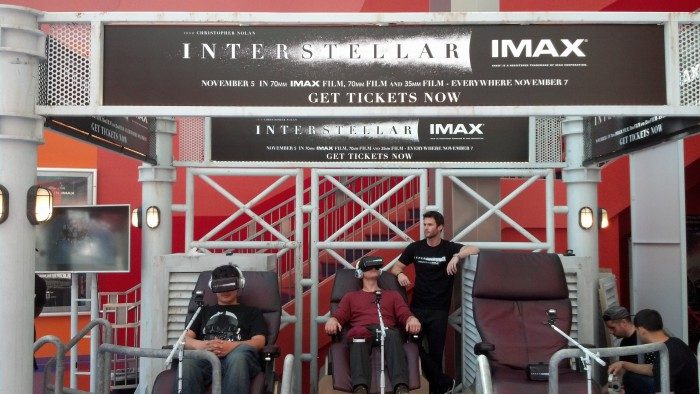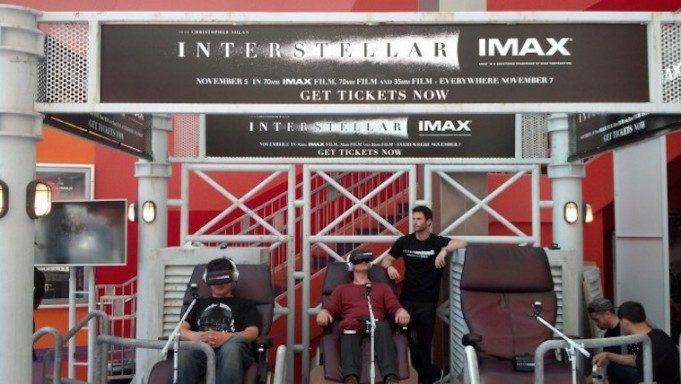
With the upcoming release of Christopher Nolan’s science fiction action thriller Interstellar, the companies behind the motion picture have taken a virtual reality marketing stint on the road to get people interested in the film. Paramount Pictures has integrated Oculus Rift DK2 headsets into custom theatre chairs that are quite comfy and a perfect seating arrangement for a brief zero-gravity ride into an intergalactic hovering station located between the stars.
The Interstellar virtual reality tour began in New York City, journeyed over to Houston, transported out to Washington D.C, flew out to London, and finally made its way down into Los Angeles. The whole marketing solution was advised by a couple of local VR influencers, including James Iliff from Survios who jumped on board around the same time that the movie production was coming to a close (which was about a year ago). Reactions from the New York City production can be seen in the video below:
While the demo was in LA, I drove over to Universal City Walk and tested out the experience. Obviously, the first thing to do was to sign a consent and release waiver with a health and safety acknowledgement in it. This guaranteed that Paramount Pictures was not liable for any problems that might arise while participating in the VR experience. It is clear that these types of legal formalities have become common place at virtual reality demonstrations in the public arena. We saw similar practices at IndieCade 2014 in Culver City and at Oculus Connect in Hollywood a while back.
See also: Virtual Reality invades IndieCade 2014
After signing the consent form, it took approximately an hour to reach the front of the line, which gave me plenty of time to talk to the staff and listen in to what to people had to say. For the most part, it was a majority of Oculus fans in attendance rather than Interstellar moviegoers who showed up at the showcase. Some of them heard about the demo from friends, while others learned about the virtual reality experience online.

One participant named Raul said that it was his first time trying virtual reality since the 90’s. The last time he’d donned a headset was in an arcade a few decades ago where he was thrust into the juddery world of Dactyl Nightmare; and boy have things changed since then! Raul was excited for the gaming content that will come from the recent rise in VR, as we discussed these things while standing in line. However, after trying out the device, he was concerned with the screen resolution, but I quickly assured him that it only gets better from here.
The experience itself starts with the user sitting in a modified theatre chair and putting on a DK2 with an Interstellar sticker graphic stuck to the front. Looking around while inside the virtual world showed that the developers had opted to put people inside a computer generated model of the Interstellar spaceship known as ‘Endurance’ which they guided people through as objects floated by. A pen for instance surfaced while journeying through the ship. It hovered so close that it was instinctual to reach out in an effort to grab it. Alas, there was no hand tracking mechanisms embedded in this particular experience. However, the added immersive benefits of the rigged-up haptic chair made up for the lack of personal presence.
The chairs were hooked together by a passionate team of engineers from the Vancouver-based startup Thinking Box. These guys have been working on the 4D Interstellar experience for a while and have been actively involved in the process, which can be seen through the pictures (like this one in Houston) that they’ve uploaded to their Twitter account.

Circuitry for the chair was controlled by a Mac computer which routed automated commands to an Arduino controller that was connected to an air compressor hidden behind one of the posters for the movie. The program that triggered the hydraulics in the chairs was coded in Python while the experience itself was built in Unreal 4 by the imaging production company known as Framestore. This setup allowed the ride to induce a zero-gravity sequence causing the person sitting in the chair to feel like they were floating through space.
Sound was pumped in through a couple of XLR cables, and the whole system was internally networked together with a direct connection to a control box with Ethernet cables attached. This gave the developers the ability to put all three of the people sitting in the chairs into the same experience together, if required. Early in the day, everyone wore JBL headphones with the Oculus Rift headsets, but as time went on, one of the chairs was upgraded to a pair of slick new noise cancelling Beats by Dre.
The experience was a lot of fun and definitely had that sense of floating in outer space. The hyperdrive shot at the end was a little weak, and there were a couple of glitches when moving out of the DK2 camera’s range, but overall it was a really good ride. It was so realistic that one of the staff members at the theatre said that a little girl around the age of 7 tried out the experience and started to get upset because she thought it was too real. Despite that incident, most of the people had a thoroughly fun time.
The question now becomes, with the success of this VR experience, will more cinemas start to integrate VR technologies into their business models? This demonstration showed that pairing up movie viewing experience with virtual reality is a win-win for everyone involved. The people enjoyed it, and it brought in a lot of moviegoers to check out the experience. If everything progresses like it is now, we should be seeing more of this type of VR integration in the near future. So be on the lookout for something like this coming to a cinema near you soon!







